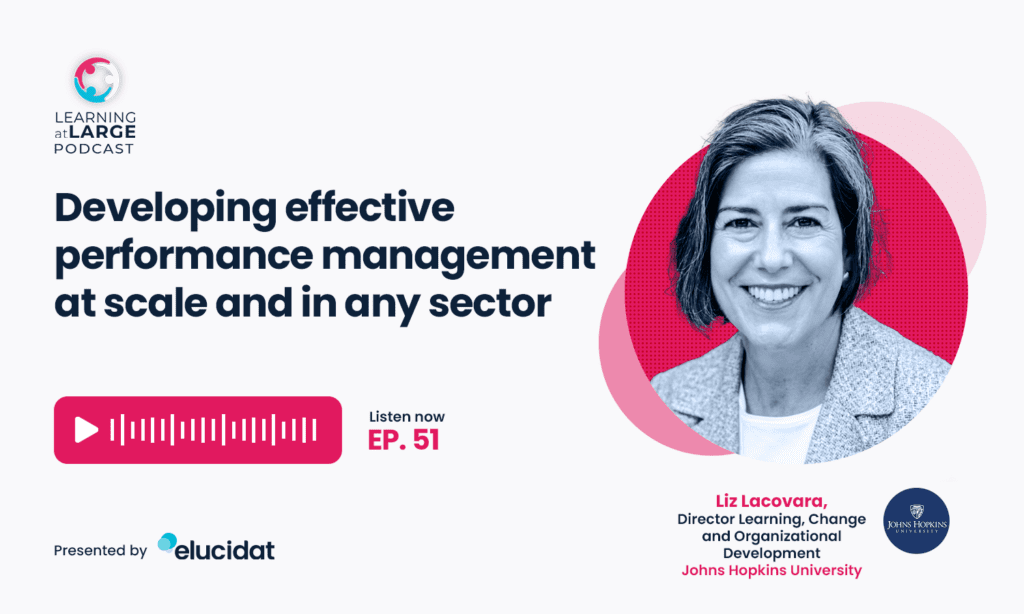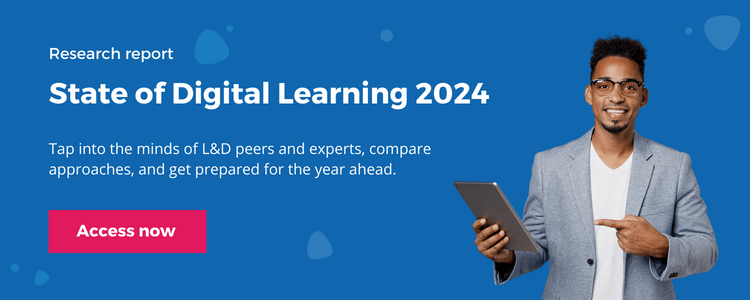Developing Effective Performance Management: Liz Lacovara
Performance management is critical in every organization – whether it’s a global brand leader or a large academic institute. Hear Liz Lacovara, Director Learning, Change and Organizational Development at Johns Hopkins University, reflect on her shift from corporate to not-for-profit. Find out how the same barriers to managing performance are faced everywhere. Discover how taking a different approach to measurements and insights is key to showing the value of L&D.

Top tips for driving employee performance and capability
Don’t have time to listen now? Here are some top tips from Liz:
- Create a shared learning culture: A culture of learning and innovation is key to overcoming your organization’s challenges. Support everyone to play their part.
- Get aligned on performance: If people don’t see an impact, they won’t value L&D. Get clear on the performance needed. Measure your impact and share your results.
- Think like a marketer: Your learners are consumers of your products and services. If they come back for more, you’ve got a clear sign of L&D success.
- Activate learning at work: L&D doesn’t end when a learning course is marked as complete. Activate learning in work by building in long-term goals.
1. Create a shared learning culture
When Liz made the shift from corporate to not-for-profit, she saw the same challenges she’d faced at other organizations. Is there enough budget? How do you keep your content up to date? How do you encourage busy people to make the time to invest in their development?
For Liz, the key to meeting these challenges is understanding your organization’s attitude to L&D. At John Hopkins University, she’s responsible for learning across 11 divisions and campuses in multiple countries. From faculty to administrators, creating a shared culture of learning and innovation was critical.
“It’s really important to understand how the organization values [L&D]…Workplace learning is a strategic imperative, particularly because of the rate of innovation and market change…It’s not human resources anymore. It’s talent development. It’s not learning and development anymore. Its performance improvement. The language suggests it’s about how work needs to get done and the kind of mindset and the culture that’s needed.”
2. Get aligned on performance
If your people don’t have the time and space to focus on learning and development, that’s one thing. But if they go through your learning content, and it doesn’t have the required impact, then you’ve got a problem. If your employees or stakeholders don’t see an impact, they’ll lose interest.
Showing the value of L&D is essential. Liz says this starts at the top with getting alignment on the performance changes required. Then you need to identify effective measures of this impact. And, of course, you need to measure it.
“One of the things that really attracted me to joining was that Hopkins was preparing to do its largest data conversion…It really was an opportunity for us to try different things and learn. And in terms of impact, it’s pretty concrete: Can I use the system?…So right away we got that reaction. What are the questions that are coming to the Service Desk? What are the problems that our people facing? Let’s course correct some of the training in real time, because we have so much feedback so fast…It was a proof moment for partnering with the business to enable organizational capability.”
3. Think like a marketeer
When it comes to understanding your impact, you need to move beyond the traditional measures of attendance and completion.
Liz is clear that you need to think like a marketer. Your learners are consumers of your products and services. Awareness gets you into the consideration set. But if they don’t buy it, or you don’t get their repeat custom, that’s clear feedback.
“What we’re trying to do is get insights into people. You know, what’s driving them to behave the way they do? What’s getting in the way of the behavior that we might want to see? And then L&D is part of what fills that gap. Yeah, I think if you’re a marketer at heart, then you’ll make a really great L&D professional as well.”
4. Activate learning at work
L&D is more than just training. It’s about capability building. And this doesn’t end when a learning course is marked as complete.
Liz gives the example of developing managers’ approach to giving feedback. After attending training, she wanted to find ways to extend their learning and maximize its impact. With systems training, it’s easy because your employees have to use the system. But for behavioral change, you need to activate learning in work by building in goals. The annual appraisal is a great opportunity for this.
“Last year in Development and Alumni Relations in one of the divisions, we introduced a shared manager goal for anybody who’s supervised people. And, you know, what gets done, gets measured. And so that has increased people’s focus on the foundational elements of being a manager, because they’re going to be measured on it.’’
A quick recap
L&D is about changing behavior and improving performance. But this isn’t always easy to achieve in large, complex organizations. Liz has four strategies to develop an effective performance management process wherever you work.
- Create a shared culture of learning and innovation.
- Get aligned on performance changes required and measure your impact.
- Think like a marketer and focus on understanding your people.
- Activate learning in work by building in goals.
Want to find out more of Liz’s tips for learning managers? Check out the full podcast.
About Liz
From global brands to boutique consultancies, Liz has over 30 years’ global multi-sector experience in talent development. She’s currently driving workplace learning and change as Director Learning, Change and Organizational Development at John Hopkins University.
You can find out more and get connected with Liz on LinkedIn.
On Liz’s reading lists
Find out what reading has informed Liz’s approach to workplace learning.
Start With Why: How Great Leaders Inspire Everyone To Take Action, Simon Sinek
Liz is a great believer that L&D should be engaged with behavioral and organizational science. She’s a big fan of Simon Sinek’s work.
Drive: The Surprising Truth About What Motivates Us, Daniel H. Pink
How do you motivate people to learn? This book helped Liz look at her learners as people in systems and think like a marketer.
Looking for more reading tips? Check out our book blog.
Learn more from like-minded learning experts
Interested to hear more from Liz as well as other learning experts and your L&D peers? The State of Digital Learning Report is the place where you can tap into the minds of your L&D peers and learning experts, compare approaches, and get prepared for the year ahead.
